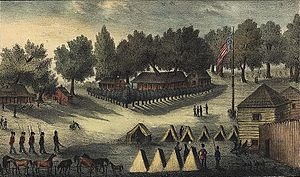Fort Brooke facts for kids
Fort Brooke was an important military base built in 1824. It was located at the mouth of the Hillsborough River in what is now Tampa, Florida. The fort was first built to keep an eye on the Seminoles, a Native American tribe. They had been moved to a special area by a peace agreement called the Treaty of Moultrie Creek in 1823.
Fort Brooke became a main military center and port during the Second Seminole War (1835–1842). The town of Tampa grew up just north of the fort during this time. The area also saw a small battle during the American Civil War. After the Civil War, fewer soldiers were stationed at the fort. It was officially closed down in 1883. This happened just before Tampa started to grow very quickly.
Today, Fort Brooke's old location is in the southern part of downtown Tampa. It was along the eastern side of the river and the Garrison Channel. Many of the fort's buildings were where the Tampa Convention Center is now. The military area stretched from the Tampa Bay History Center to Curtis Hixon Waterfront Park. Many modern buildings, like Amalie Arena and parts of the Tampa Riverwalk, are now on the fort's old land.
During construction projects, old cemeteries for soldiers and Seminoles were found. Many old items were also discovered. The soldiers' remains were moved to the Florida National Cemetery in Bushnell. The Native American remains were given to the Seminole Tribe of Florida. The old items went to the Tampa Bay History Center and other places for study.
Building Fort Brooke
In 1823, two colonels from the United States Army, George Mercer Brooke and James Gadsden, received orders. They were told to set up a military base on Tampa Bay. This new base was in the Florida Territory, which the U.S. had recently acquired. The goal was to keep the Seminole Indians in their assigned area. It also aimed to stop illegal activities along the Gulf coast.
On January 10, 1824, Colonel Brooke and his soldiers arrived. They were from the U.S. 4th Infantry Regiment and came from Pensacola. They set up "Cantonment Brooke" at the mouth of the Hillsborough River. This spot is now where the Tampa Convention Center stands in downtown Tampa. The site had a huge hickory tree on top of an old Indian mound. This mound was likely built by the Tocobaga culture many centuries ago.
Colonel Brooke told his troops to clear the land. They built a wooden log fort and other support buildings. However, he made sure to save several old live oak trees inside the camp. These trees provided shade and made the area look nicer. Later in 1824, the base was officially named Fort Brooke.
Fort Brooke's Role in History
Fort Brooke became a very important military base on Florida's west coast. It played a key role during all three Seminole Indian Wars. It was also active during the Civil War. The fort helped the small village of Tampa grow into a town.
In October 1863, a small battle took place near the fort. This was called the Battle of Fort Brooke during the Civil War. On May 6, 1864, both Fort Brooke and Tampa were taken over by Union forces.
As Tampa struggled in the 1870s and early 1880s, Fort Brooke also saw fewer activities. The last time soldiers were counted at the fort was in 1882. The U.S. Army officially closed the base in 1883.
After the Fort Closed
After Fort Brooke was closed, most of its land became available. People could claim the land to build homes. Some of the fort's old buildings also remained on the site.
Soon after the military post was shut down, Fort Brooke became its own town. This happened in 1885. However, Fort Brooke did not stay independent for long. In 1907, it was officially joined with the city of Tampa.


